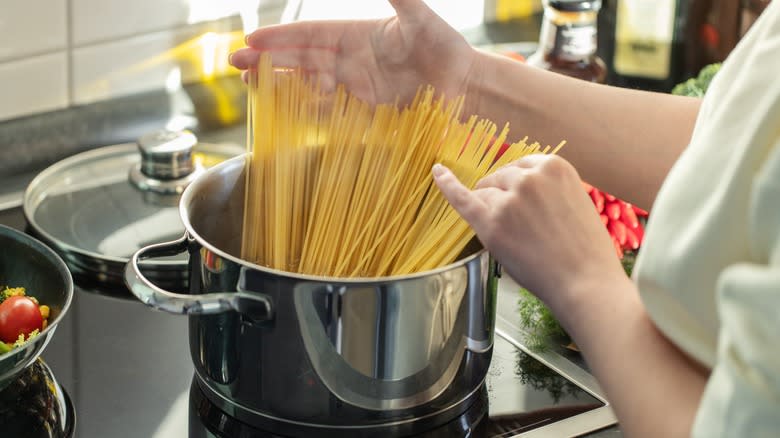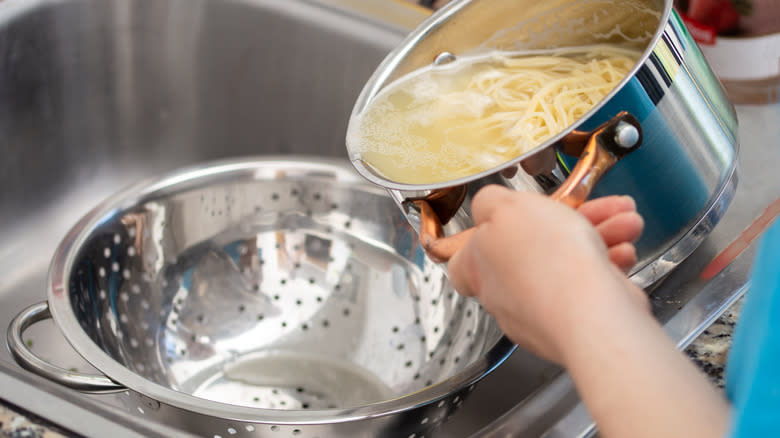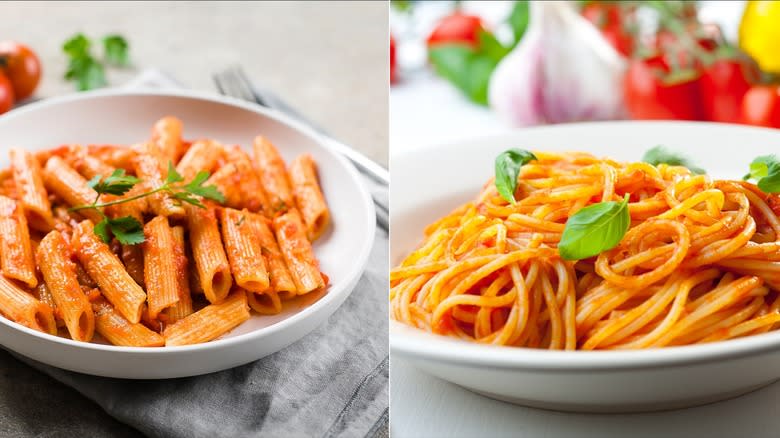The Genius Hack For Cooking 2 Types Of Pasta In One Pot

Occasionally, members of your household might not agree on which pasta shape they want for dinner. Half of them want a long, slurp-able noodle. The other half want pasta shapes that they can pierce with their forks, scooping extra sauce along the way. Of course, you really don't want to boil separate pots of water so that everyone can have their preferred pasta for dinner. Thankfully, there is an easy solution to cook two types of pasta in one pot!
Rose Reisman of The Art of Living Well explained this handy hack on Instagram. First, boil a large pot of salted water as you normally would. Then, take the pasta that will take longer to cook, and place that in the pot first. Stir it for a little while to make sure the pieces do not stick to each other. Then, place a heat-safe metal strainer into the water, and add the pasta that will take less time to cook into that strainer. Voilà, there are now two different pastas boiling together in the same pot! Simply remove the second, quicker-cooking pasta when it is done (the pasta water should strain right back into the pot) and continue boiling the first, longer-cooking pasta until that is done as well. Divide the prepared sauce accordingly, toss both types of pasta separately, and dinner is served.
The most finicky thing you have to remember is to set two separate timers for the different pastas. But for the sake of less cleanup, this hack is pretty worth it.
Read more: The Best Kitchen Gadgets You Can Buy
Why Not Skip The Strainer And Cook Both Pastas Together?

So why not just mix the two pasta shapes together in the pot? Other than the fact that separating a whole bunch of wobbly pasta pieces after cooking is a chore and a half, cooking them mixed up together does not take into account the concept of "al dente". You probably have heard of this Italian phrase, which translates to "to the tooth." It's the stage when a cooked pasta's texture is still just a little bit firm, so it can continue to cook in the accompanying sauce without turning to mush.
Thanks to the different shapes and thicknesses of different pastas, cooking times to reach the al dente stage vary according to the pasta type. Thinner ones cook faster, as do shapes that have fewer folds. So, if you cook two pasta types together, it's difficult to remove one variety of pasta when it's reached the al dente stage but the other hasn't. You'd have to remove both pastas from the boiling water despite their different cooking times, which could result in one type of pasta that's perfectly al dente, but another that's hard and undercooked or mushy and overcooked.
Of course, you could always try timing your pasta perfectly by adding the longer-cooking pasta first, and then waiting a few minutes before adding your faster-cooking pasta. But this method still leaves a pretty large margin of error, while the strainer method allows you to keep total control over the cooking times of both pastas.
Same Sauce, Different Pasta

Even though there are technically "right" types of sauces for your pasta, sometimes you only have the wherewithal to prepare one kind of sauce for dinner, and that is okay. It may not be ideal to pair pesto with long and thin pastas, or to use penne in an aglio olio, but it is admittedly easier to cater to a preferred pasta shape than it is to a preferred sauce as well — at least with pasta shapes, you now know it can be cooked in the same pot with ease.
To help counter this saucy dilemma, tomatoes offer a happy compromise. This Italian tomato sauce is essentially a classic marinara, not only good for almost any pasta shape, but also for dipping garlic bread. Another tomato-ey hit for multiple pasta shapes is this spicy Roman-style all'arrabbiata.
And if your family is not a fan of tomatoes? Just pair the different pasta shapes with whatever sauce you can make. While there are pasta rules you should never break, you could certainly bend them, with deliciously satisfying results.
Read the original article on Daily Meal.

 Yahoo News
Yahoo News 
